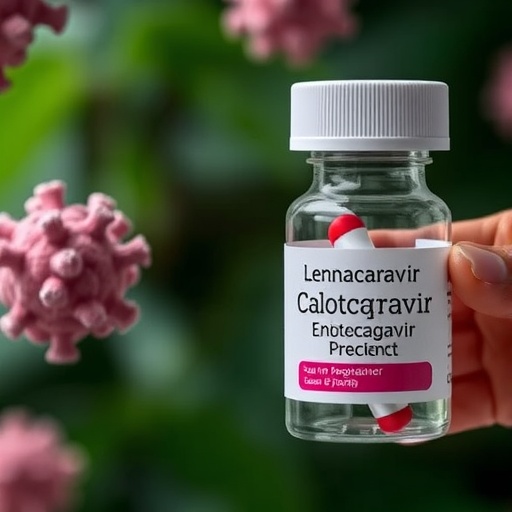
In a groundbreaking development poised to redefine HIV treatment paradigms in Africa, a recent study explores the transformative potential and cost-effectiveness of combining long-acting injectable antiretrovirals—lenacapavir and cabotegravir. This innovative therapeutic approach stands on the cusp of revolutionizing adherence, viral suppression, and ultimately, the trajectory of HIV epidemics across the continent. Published in Nature Communications, the study by Phillips, Smith, Bansi-Matharu et al. meticulously quantifies the prospective health benefits and economic viability of this dual-agent injectable regimen, highlighting its promise as a scalable strategy in resource-limited settings burdened by high HIV prevalence.
Traditional oral antiretroviral therapy (ART) regimens, although effective, face pervasive challenges including pill fatigue, stigma associated with daily medication, and suboptimal adherence. These obstacles contribute substantially to viral rebound and the emergence of drug resistance. The introduction of long-acting injectable agents offers a paradigm shift by drastically reducing dosing frequency from daily tablets to monthly or even less frequent clinic visits. Lenacapavir, a first-in-class capsid inhibitor with extended half-life properties, when combined with cabotegravir, an integrase strand transfer inhibitor also formulated for long-acting delivery, creates a potent, synergistic duo that maintains therapeutic drug levels over prolonged periods.
The study employs sophisticated epidemiological modeling integrated with economic analyses to simulate the impact of deploying this injectable combination throughout various African settings characterized by diverse HIV epidemiology, healthcare infrastructure, and socio-economic factors. By operating within real-world constraints, the research presents a nuanced picture of how such a regimen could alter HIV incidence and prevalence through improved adherence, reduced transmission, and enhanced viral suppression rates. Importantly, it quantifies not only clinical outcomes but also health system costs and cost-effectiveness, a critical consideration for policy implementation in countries with limited healthcare budgets.
.adsslot_joJZT3KXgL{width:728px !important;height:90px !important;}
@media(max-width:1199px){ .adsslot_joJZT3KXgL{width:468px !important;height:60px !important;}
}
@media(max-width:767px){ .adsslot_joJZT3KXgL{width:320px !important;height:50px !important;}
}
ADVERTISEMENT
One of the most compelling aspects underscored in the study is the potential for long-acting injectable therapy to alleviate the adherence burden that compromises conventional ART success. The monthly or bimonthly administration, often directly observed in clinical settings, minimizes the risk of missed doses and the consequent viral rebound. This approach is particularly advantageous for populations facing structural barriers—such as rural residents, key populations experiencing stigma, and individuals with unpredictable lifestyles. By improving retention in care, the injectable regimen could substantially suppress community viral loads, thereby reducing onward HIV transmission at a population level.
Lenacapavir occupies a unique space mechanistically; as a capsid inhibitor, it disrupts the viral capsid’s integrity and lifecycle, targeting multiple stages from capsid stabilization and nuclear import of the viral genome to assembly and release of new virions. This multifaceted mechanism diminishes the likelihood of resistance emergence. When partnered with cabotegravir—which inhibits integration of viral DNA into the host genome—this dual formulation operates on complementary viral processes, enhancing antiviral potency and reducing the probability of treatment failure.
The modeling framework integrates data from clinical trials, demographic surveillance, and real-world adherence studies, allowing projections over extended timelines. By simulating scenarios with varying degrees of regimen uptake and retention, the analysis reflects realistic implementation pathways. Cost components considered include drug acquisition, administration infrastructure, laboratory monitoring, and clinic visits. Compared against standard oral ART, the injectable combination demonstrates favorable incremental cost-effectiveness ratios in most modeled contexts, indicating good value for money within widely recognized cost-effectiveness thresholds.
Beyond economics and efficacy, the study addresses potential implementation challenges, emphasizing the need for robust supply chains, healthcare worker training, and patient education. Vaccine-like delivery models could be explored to streamline administration, while decentralized distribution points may enhance accessibility in remote areas. Ethical considerations, including equitable access and consent processes for injectable therapies, are paramount to ensure the benefits percolate across all strata of affected populations.
Moreover, by reducing regimen complexity and enhancing convenience, this injectable strategy may also indirectly reduce HIV-associated stigma. The discrete nature of clinic-based injections can circumvent the daily visibility of pill-taking and minimize medication-related reminders, which often pose psychological and social barriers. Enhanced confidentiality may encourage earlier initiation of treatment, improving individual health outcomes and epidemiologic control.
The timing of this study is particularly auspicious, as global HIV control efforts strive to meet the UNAIDS 95-95-95 targets—95% of people living with HIV knowing their status, 95% of those diagnosed receiving sustained ART, and 95% of those on ART achieving viral suppression. By potentially elevating viral suppression rates through improved adherence, lenacapavir plus cabotegravir injectable therapy could be an essential tool to accelerate progress toward epidemic control goals in sub-Saharan Africa, home to the majority of the world’s HIV burden.
It is also important to recognize the role of scientific innovation in expanding therapeutic options for complex chronic infections such as HIV. The development of novel molecules with extended half-lives challenges traditional daily pill regimens and paves the way for combination formulations tailored for long-term, simplified administration. Such advancements echo broader trends in infectious disease management and personalized medicine, underscoring how pharmacologic chemistry, virology, and health economics converge to craft sustainable global health interventions.
Furthermore, the potential scalability of this intervention holds promise for health systems severely strained by high patient volumes and logistical challenges. Reduced frequency of drug dispensing decreases healthcare worker workload and clinic congestion, freeing resources for other critical services. The injectable approach could synergize with other prevention strategies including pre-exposure prophylaxis (PrEP), voluntary medical male circumcision, and expanded testing initiatives, creating a comprehensive, multilayered response to HIV transmission dynamics.
Despite the enthusiasm, the authors caution against premature broad-scale deployment before addressing open questions such as long-term safety, resistance surveillance, and cost negotiations with pharmaceutical manufacturers. Equitable pricing and inclusion of marginalized populations in roll-out plans are indispensable to prevent exacerbating health disparities. Moreover, integration with existing ART programs requires careful coordination to avoid disruption of established patient care pathways.
In the landscape of HIV therapeutics, where incremental gains matter immensely, this study’s insights illuminate a promising future wherein sustained viral control is achievable through innovative drug delivery mechanisms. The prospect of a once-monthly injectable that combines formidable pharmacodynamics with cost-effectiveness could redefine treatment accessibility, adherence, and ultimately, the course of the HIV epidemic in Africa.
In summary, this comprehensive examination of long-acting injectable lenacapavir plus cabotegravir therapy underscores the potential for a paradigm-shift in HIV treatment, especially within the African context. By demonstrating that enhanced adherence facilitated by reduced dosing frequency can translate into both improved clinical outcomes and economic efficiency, the research lays a solid foundation for future policy decisions. As the global health community races to end the HIV epidemic, such innovations illuminate a path toward equitable and effective care.
Subject of Research: The potential impact and cost-effectiveness of long-acting injectable lenacapavir combined with cabotegravir as HIV treatment in Africa.
Article Title: Potential impact and cost-effectiveness of long-acting injectable lenacapavir plus cabotegravir as HIV treatment in Africa.
Article References:
Phillips, A., Smith, J., Bansi-Matharu, L. et al. Potential impact and cost-effectiveness of long-acting injectable lenacapavir plus cabotegravir as HIV treatment in Africa. Nat Commun 16, 5760 (2025). https://doi.org/10.1038/s41467-025-60752-y
Image Credits: AI Generated
Tags: adherence to HIV medicationchallenges of traditional oral ARTcost-effectiveness of HIV treatmentsdrug resistance in HIV treatmenteconomic viability of antiretroviral therapyHIV treatment innovationslenacapavir and cabotegravir combination therapylong-acting injectable antiretroviralsresource-limited settings and HIVscalable strategies for HIV epidemics in Africatransformative potential of HIV therapiesviral suppression in HIV patients



